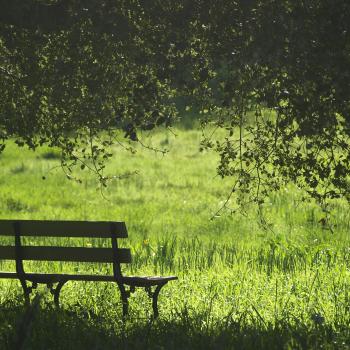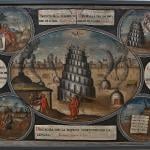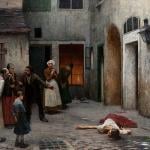By Allison Backous Troy
May the Lord bless thee out of Zion; and so shalt thou behold the good things of Jerusalem all the days of thy life. —St. Gregory of Palamas
Last night, I dreamed that I was in Montana. My neighborhood looked like the one I live in—same Tudor house, same cul-de-sac, same wooded corner where I take my dog for morning walks. But there were mountains to the south, gray and wide, and the grass was a rust-colored brush, dry and prickly beneath my feet.
My only visit to Montana, in real life, was a thirty-minute layover on the way to Seattle. I have no way of knowing Montana other than television shows, travel ads, and other superficial images.
But I know that, in my dream, there was a moment when preconception gave way to knowledge, a knowledge that made me feel awake, alive, sure that I knew where I was. In the dream, I stood on the scratchy ground and watched the sky turn from sunset to dark, and a burst of stars opened above me, bunched together in bright knots against the blue-black stretch of night.
And I gasped, and said to myself, “These are stars. This is Montana.”
I have spent my whole life as a writer trying to string together these kinds of moments. Moments when the veil has been slit open, when I have been able to catch a glimpse of how God has held my life together.
In examining our lives, we look for patterns to make sense of things, keys to unlock the truths we imagine hold our stories together. I once tried to present a thesis stating that Gerard Manly Hopkins’s use of sprung rhythm directly reflected his spiritual life, and my professor smiled hesitantly.
“We have to be careful about thinking that one thing directly reflects another,” he said. “No single piece of information can completely unlock a life.”
I suppose the same holds true for me—maybe all I can do is avoid the thesis, the attempt to bind it all together too early. Maybe all I can do is lay out the moments when I’ve known where I was, what I felt, what I have seen in my life.
People get disgusted with memoir very easily—the oversaturation of testimonies, tell-alls, and exposés makes it hard to believe that people’s lives are worth recounting. What makes a life different, instructional, inspirational, even?
For me, those are consumeristic questions. They suggest that the value of a story is what we can get from it, what a story can offer us.
What that desire implies, for me, is that we are actually seeking something deeper. We want to live rightly; we want instruction, but most of all, we want to know that there is a form that holds us, an image that doesn’t just unlock life, but imbues it, reveals to us that in the divorces and war zones and dreams we live through, the beauty and the salvation we keep looking for is really, truly there.
We spend our lives seeking the good things of Jerusalem. And as I look at the strings of moments I can recollect, I realize that I might just be looking for a place to hold them, what memoirist Patricia Hampl calls a “habitation” for story, memory, witness—a space to arrange my memories where, in their proper place, they might all speak together, say the things that I long for them to say.
And what is it that I long to hear?
That it’s true that, as a girl, I spent Sundays waking up early and getting ready for the church we never went to, my white patent leather shoes clacking down the hallway while my parents slept, the house gray and quiet in the early morning?
That, during the strobe-lit praise songs of my high school youth group’s worship services, the frantic raising of my hands locked me in a frenzied, anxious prayer that was more wounded than holy?
That the homes of my professors and friends in college relaxed that frenzied prayer, taught me how to breathe, and trust, and cry over what I had been stifling my whole life—the belief that I was completely and totally unloved?
That the oil my priest dabbed on my forehead and hands this past month did not just welcome me into the embrace of God, but opened my eyes to see, just a bit more clearly, that I have been held and loved all along?
There are so many arcs of movement in our lives, and it is impossible for me to say how all those movements hold together. But I can begin building a place for them to dwell. This page, this line, and all the lines preceding them are taking shape beneath my feet.
And I can see, or at least hope to see, a small space bursting before me, something that will make me say to myself, to us, “This is true. This is true.”
Originally published in Good Letters on July 19, 2012.
Allison Backous Troy teaches lives and writes in Boston, MA, with her family.
Photo above credited to Christina and used under a Creative Commons license.












